There’s no arguing with some health advice: cigarettes? Quit ’em. Vegetables? Eat ’em. Cross trainers? Sweat your shrinking glutes all over ’em.But not all health advice is so clear-cut.
That’s because the advice we first got from our mum goes against the advice your girlfriend read somewhere,
which goes against what your GP once said, which goes against the latest news report,
which goes against what you read on the back of the cereal packet.
To bring some sense to this swirl of conflicting info,
we take a look at those health concerns that straddle the line between hype and fact
so you can decide what’s worth taking precautions over and what you can stop thinking about.
Having Kids After Age 35?
Somewhere between the increasing availability (and success rates) ofIVF and SIP, women started having babies later.
In Australia, more babies were born last year to mums in their mid to late 30s than to twentysomething women,
according to the Australian Bureau of Statistics.
Medically speaking, a woman who’s going to be 35 when she delivers is at “advanced maternal age”
(a nice way of saying your eggs may start coming out scrambled instead of soft-boiled).”
I don’t discourage women over age 35 from getting pregnant;’ says Dr Bradley Goldberg, an obstetrician and gynaecologist.
“The vast majority of women who get pregnant after age 35 are going to have normal babies and healthy pregnancies.”
But getting a double line on a pregnancy test may be more difficult, and the chance that a 35-year-old will have a miscarriage is 20 per cent,
compared to nine per cent for women in their 20s, according to a study in the British Medical Journal. With an increase in age, you’ll also see
lO Cancer Hungfoods to Eat all year Long.
A healthy, balanced diet is key. Blackberries, raspberries, strawberries and blueberries contain antioxidants such as polyphenols, which counteract and repair cell damage.
Out of season? Frozen berries are just as good. And tasty.
higher risks of birth defects. According to the US National Institute of Child Health and Human Development,
the risk of having a baby with Down’s Syndrome or other genetic defect increases from less than 1 in 1000 in women under 30 to one in 400 by age 35,
one in 180 at age 38, one in 105 at age 40 and one in 12 by the time a woman is 49.
If you’re pregnant and over 35 your GP or obstetrician may recommend an in-depth sonogram or an amniocentesis to test for levels of birth defects.
Tests won’t prevent birth defects, but it’s recommended for women over 35 so they can learn more about risks and potential problems.
Taking the pill for umpteen years?
Some people think taking oral contraceptives is like working at your desk for too long. Take a break and you’ll feel better.
Advice about on-again, off-again pill-taking may have stemmed from early research about hormonal side effects – specifically cancer, birth defects, blood clots or weight gain.
But the pill was high in hormones when it arrived in 1960; today most oral contraception is low in hormones. “Some doctors used to say, ‘You’ve been on the pill a while.
Let’s come off it for a few months and give you a rest. But there really have been no studies that have shown it’s beneficial to get off the pill.
In fact, Dr Goldberg says there’s a high risk of unintended pregnancies with such breaks. And staying on the pill long term can actually have health benefits.
While women have a 10 to 20 per cent chance of getting breast cancer while on the pill, studies also show that the hormones can reduce risk of uterine cancer by 40 per cent after two years of being on it and 60 per cent after four years.
Ovarian cancer risk decreases 50 per cent after four years and 80 per cent after 10 years.
And if you smoke, here’s one more reason to quit: a study in the American Journal of Obstetrics and Gynecology showed that smokers taking oral contraceptives are 30 times more likely to have a heart attack.
Breaking My Bones?
Bones, schmones. No need to worry about osteoporosis (which accounts for fractures in one of every two women over 50) until you get your pensioner card. Right?
~Shiitake and maitake mushrooms are a staple food in Japan.
They’re even found in Japanese and Chinese hospitals, where they’re provided to patients during chemotherapy treatment.
They contain a molecule called lentinan which stimulates the immune system.

~Organic Acai contains all the amino acids that you body needs,
and it is the most powerful super food in the world which is packed with antioxidants.
~Turmeric contains curcumin, a powerful anti inflammatory.
So go a yellow curry once in a while.
~Mint, rosemary and basil are rich in fatty acids of the terpene family,
which makes them particularly fragrant (and great for packing loads of flavour into your food).
Terpenes have been shown to reduce the spread of cancer cells.
Wrong – now’s the time to build strong bones. You reach peak bone mass about the age of 25.
It stays stable until your 30s and 40s and then starts to decrease, leaving your bones more porous and fragile.
That loss may be caused by hormonal changes, less physical activity, chronic disease, a crappy diet, smoking or excessive alcohol intake, says Professor Peter Ebeling, medical director of Osteoporosis Australia.
Since osteoporosis medications are only effective for post menopausal women, the best prescription for you is prevention.
Calcium and exercise may have the power to prevent osteoporosis, though ask your parents if you have a family history as that puts you at a greater risk.
Professor Ebeling advises getting at least 1000mg of calcium a day from dairy products or calcium fortified foods.
Do weight-bearing exercises – which work against gravity to support body weight – three times each week.
For instance, while jogging, dancing and aerobic classes elicit the secretion of cell chemicals that produce bone mass and help prevent bone loss, weight training three times a week has been shown to maintain bone density.
Another reason to sweat: “Exercise increases muscle mass and function, which reduce the risk of falling and improve the odds that if you do fall,
you’re not going to have a fracture,” says Dr Felicia Cosman, clinical director of National Osteoporosis Foundation in the US.
Having a Heart Attack Before I’m 40?
The standard image of a heart attack victim: male, about 65, overweight, Big Mac in one hand and a beer and a sausage sanga in the other.
Yes, we know that’s not you. In fact, not that many women under 40 have heart attacks. But if a young woman does, her chances of death are greater than a man’s.
That’s probably because it takes women about 30 to 60 minutes longer to respond to potential cardiac symptoms.
“We often fail to recognise the symptoms and don’t call 000 until it’s too late,” says Julie Mitchell, cardiovascular health director at the Heart Foundation.
Either we don’t recognise what the symptoms mean or we’re saying to ourselves, “This isn’t serious, it’ll go away.”
Those symptoms include discomfort in your chest, arms, neck or mouth; shortness of breath; general fatigue; and sweating.
It’s especially important to get immediate help if you’re most at risk for early heart attacks (female smokers have a sixfold risk, and diabetics and women with high cholesterol are prime candidates).
So stay on top of your numbers to determine your chances of coronary-artery disease – the cause of heart attacks. Blood pressure should run less than 120/80mmHg.
Bad (LDL) cholesterol should be less than 100mg/dL and good (HDL) cholesterol greater than 50mg/dL.
The other figure you need to keep in check is your waist circumference. You should aim for 80cm or less –
women with mid-sections larger than this are more at risk of heart disease, and more than 88cm poses a “dangerous risk”,
according to the World Health Organisation and the National Health and Medical Research Council.
My Poor Posture?
Standing up straight will do more than satisfy finger shaking mums. “When you slump, you compress those discs between the vertebrae,” says chiropractor Dr Jerome McAndrews.
“They want to return to their normal configuration.” When the spine becomes accustomed to bad posture, everything else goes askew.
For instance, slumping compresses and shrinks the chest and abdominal cavity, which may cause shortness of breath and digestive problems like constipation.
If, at a profile’s glance, your ears aren’t aligned above the shoulders, you have poor posture. Luckily, repairing shoddy posture is
as easy as acquiring it. Sit with a small pillow behind the small of your back to maintain the normal curve in the spine. Your lower back should curve slightly forward,
the upper back slightly backward, and the neck forward again.
Sitting for long periods of time causes the muscles in the backs of your legs to shorten, throwing our pelvic bones off-kilter and inciting a hunch.
Get up often and switch crossed legs to stretch those muscles.

For half an hour a day, sit cross-legged on a pillow to stretch the groin ligaments and realign the pelvic bones, Dr McAndrews suggests.
And while Gary Castle may not want to hear
it, your back will: avoid wearing high heels,
because they contract and shorten the muscles in the backs of the legs and tilt the pelvis to distort your alignment.
X-rays?
Not unless you’re stashing diamond chips in your fillings.
Typically, low doses of radiation, like during medical X-rays, won’t cause cancer.
Actually, radiation emitted during typical medical X-rays is lower than the range you absorb from the natural environment (from the sun, rocks, plants, water and soil)
and the benefits of this exposure often outweigh the risks.
While women who suspect
they may be pregnant often discuss postponing X-rays to prevent birth defects,
research shows that X-ray exposure is extremely unlikely to harm a foetus.
Still, X-rays shouldn’t be taken just because the dental nurse suggests them.
“One only wants to have exposure when they’re getting some kind of benefit,” says radiation epidemiologist Dr Martha Linet.
Another procedure to be sure you need before you hop on to the bed: CT scans.
While 400 new cases of cancer a year are picked up (in Australia) via diagnostic radiology, according to the Cancer Council Australia, CT scans can expose patients to hundreds of times more radiation than a plain X-ray.
About the author: Bella Gritz is a Nutrition expert who writes for Infinity Store Australia.





